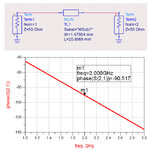rsx4729
Newbie level 5

Hi all,
I am studying about phase shifter. Some papers presented the "phase shift" versus frequency, some other papers showed the graphs "Relative phase" versus frequency. What is the different between "phase shift" and "Relative phase"? Or they are similar?
Thank in advanced.
I am studying about phase shifter. Some papers presented the "phase shift" versus frequency, some other papers showed the graphs "Relative phase" versus frequency. What is the different between "phase shift" and "Relative phase"? Or they are similar?
Thank in advanced.




